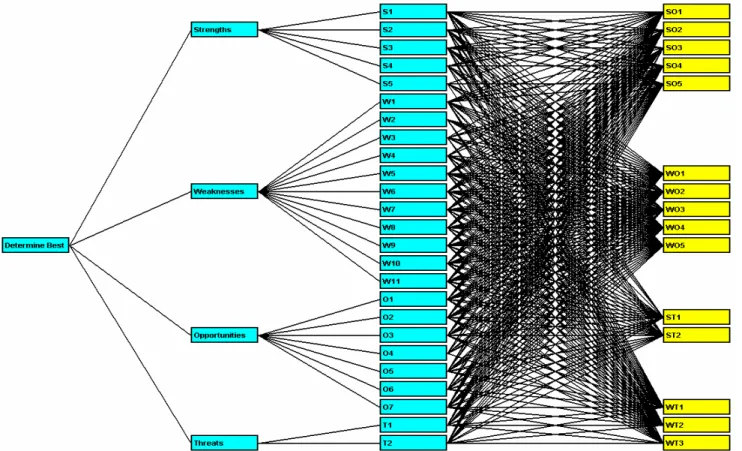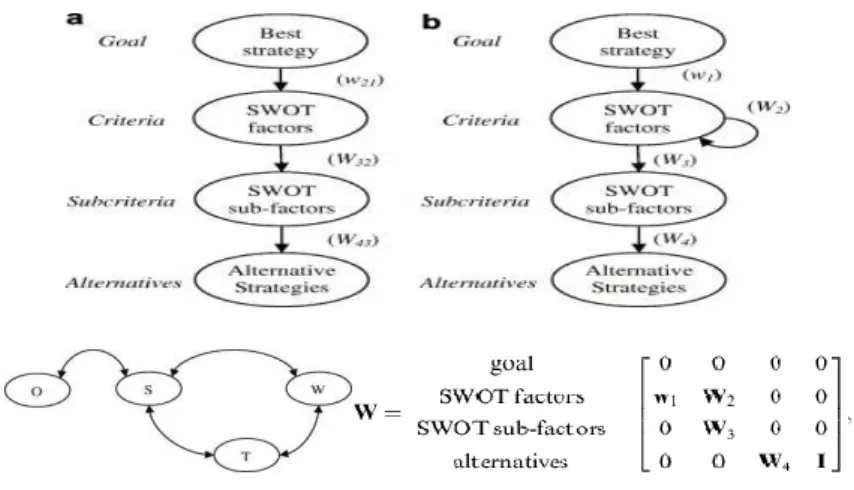Textile and Clothing Supply Chain Management: Use of Planning-Link in the Strategic Planning Process Deedar Hussain1, Manuel Figueiredo2, Anabela Tereso3 and Fernando Ferreira4
1deedar_agha@hotmail.com, 2 mcf@dps.uminho.pt, 3 anabelat@dps.uminho.pt, 4 fnunes@det.uminho.pt
1 NED University of Engineering & Technology, Karachi 75270, Sind, Pakistan 1, 2, 3, 4 University of Minho, School of Engineering, Braga 4710-057, Portugal
ABSTRACT
In the current business world setting, the strategic directions are important not only for individual entities in the chain, but the complete chain itself should be considered for analysis. This helps developing competitive advantages and retaining them. This article presents a methodology for analyzing a supply chain and describes how entities in the chain can be improved to materialize the available and potential opportunities. The use of Planning-Link for mapping the cause and effect relationship between existing status of the chain to the future or planned outputs is suggested here which makes the process of strategic planning easier and logical.
Keywords: Strategic Planning; Planning-Link; Textile and Clothing; Supply Chain Management; 1. INTRODUCTION
In the current business environment, competition is among supply chains rather than individual entities. Therefore planning for available and future opportunities in order to establish a strategic direction requires a complete analysis of the whole chain. Such an analysis on a textile and clothing supply chain from Pakistan is under discussion in this article and a methodology for developing a Planning-Link between chain entities, opportunities and strategic planning (input and output parameters) is described here.
2. METHODOLOGY
This study consists of a SWOT analysis of the textile supply chain followed by a process of strategic planning. The SWOT analysis identifies the internal and external environment for the chain including the strengths, weaknesses, opportunities and threats. The analysis was conducted through related literature review and discussions with supply chain experts and was presented in a study by Hussain et al. (2009). Once the environment of the chain is established and present status of the chain entities and available opportunities are identified, the process of strategic planning was started. Experts were consulted for the development of strategic plans and decision tools were utilized for the analysis of the plans. These tools include Saaty´s Analytical Hierarchical Process (AHP) and Analytical Network Process (ANP) which are discussed in detail by Saaty and Vergas (2006) and Saaty and Sodenkamp (2008). AHP provides a framework to analize the decision alternatives without taking into account the innerdependence of the decision elements whereas the ANP allows to take into account the innerdependence of the decision elements also. Such a methodology of using these tools in combination with SWOT is also utilized by Kurtila et al. (2000) in his hybrid method and by other authors. This kind of hybridization of these tools in strategic planning has made the process of decision making more effective and quantitative.
For explanation, we present here the analysis which we have performed on a textile and clothing chain and its results. This analysis is concluded in a study by Hussain et al. (2010). First we present the SWOT matrix and developed strategic plans in table 1.
X Congreso Galego de Estatística e Investigación de Operacións Pontevedra, 3–4–5 de novembro de 2011
Table 1: SWOT Matrix and Strategic Plans for a Textile and Clothing Supply Chain Internal Factors
Strengths Weaknesses
S1 - Indigenous cotton crop
S2 - Low wages/labour costs
S3 - Strong investment in
textiles & made-ups
S4 - Skills in ICT
S5 - Skills in chemistry (for
textile & clothing chemical industry)
W1 - Limited base of non cotton
fibres
W2 - Weak ginning sector
W3 - Lower cotton yield (per acre)
W4 - Low application & usage of
ICT
W5 - Non competitive behaviour of
entrepreneurs
W6 - Skills (technical, marketing &
management)
W7 - Distance to (current) markets
W8 - Underdeveloped logistics
W9 - Weak market awareness
W10 - Input costs and continuity W11 - Low Foreign Direct Investment
Opportunities SO Strategy WO Strategy
E x te rn al F ac to rs O1 - Technical Textile
O2 - Value added products
(fashion, children clothing & home textiles)
O3 - Closed proximity to
future potential markets
O4 - Government support for
R&D
O5 - Dyes & chemical
manufacturing
O6 - Machine manufacturing
O7 - Logistic link for Far
East to European and Middle East Markets
SO1 - Diversification of product
range
SO2 - Establishing industrial-parks with common facilities of design & development centres, ICT application centres, effluent treatment, etc
SO3 - Applying export
incentives
SO4 - Establishing downstream
links/facilities in competing regions (Turkey, Egypt, Bangladesh & Mexico...)
SO5 - Improving domestic chemical industry
WO1 - Skill development programs WO2 - Expanding non cotton fibres base
WO3 - Improving logistics
WO4 - Developing effective linkage between industry, academia and R&D institutes
WO5 - Developing domestic engineering industry
Threats ST Strategy WT Strategy
T1 - Political instability
T2 - Regional competitors
ST1 - Development of markets
access strategies
ST2 - Establishing down-stream
facilities in stable, near-to-market and competing regions
WT1 - Work in collaboration with competitors
WT2 - Development and implementation of long-term and coordinated policies
WT3 - Introduction of industry relief packages
Then a hierarchical structure was developed for the relationship between decision elements and prioritizing them within different levels and sublevels in those groups. The final weightage is given to the decision alternatives at the lowest level. Till now, the elements are considered as independent and their inner dependence is not taken into account. This structure is presented in figure 1.
Once the hierarchical relationship between decision elements was established, the process of assigning priorities was done and then the effect of the inner dependence was included. The inner dependence model for our decision problem is presented in figure 2.
In the super matrix, w1 represents the weightage of criteria (SWOT) elements; W2 represents the effect of inner
dependence at criteria level. Thus we get the inner dependent criteria weightage from Wfactors = W2*w1. W3
represents the local priorities for the sub-factors of criteria which are converted into global priorities by multiplying with Wfactors. Thus wsub-factor (global) = W3 * Wfactors. Finally the ultimate priorities of decision
alternatives are established by multiplying the priorities of alternatives calculated with respect to sub-factors (W4) and global priorities of sub-factors (wsub-factor (global)). The final results achieved are presented in table 2.
Table 2: Strategic Plans and their Importance
Strategy Importance ranking
WO4: Developing Effective Linkage between Industry, Academia and R&D
Institutes .144
WO1: Skill Development Programs .123
ST2: Establishing Down Stream Facilities in Stable, Near to Market and
Competing Regions .084
WO2: Expanding Non-cotton Fibre Base .082
SO2: Establishing Industrial Parks with Common Facilities of Design &
Development Centres, ICT Application Centres & Effluent Treatment Plants .080
SO1: Diversification of Product Range .075
ST1: Development of Market Access Strategies .073
SO4: Establishing Downstream Facilities in Competing Regions .067
SO5: Improving Domestic Chemical Industry .062
WO3: Improving Logistics .050
WT1: Work in Close Collaboration with Competitors .049
WT2: Development and Implementation of Long-term & Coordinated
Policies .040
WO5: Developing Domestic Engineering Industry .029
SO3: Applying Export Incentives .025
WT3: Introduction of Industry Relief Packages .017
The process of decision making is concluded here by the introduction of the inner dependence of criteria elements. The results achieved here are valid for strategic plans and calculating inner dependence for lower levels will only make the solution more complex.
In the above process of strategic planning, which is also followed by other authors as Yuksel and Dagdeviren (2007), we introduced a new step of Planning-Link after constructing the SWOT matrix and before developing the strategic plans which improved the process of development of strategic plans, being a key step in this whole process. This gives the advantage of generating effective plans and reasonable priorities, making the planning process more clear. The Planning-Link suggested for our problem is presented in figure 3. This link can be developed in consultation with experts which will preserve the linkage of the strategic plans with the output of their implementation already abstracted. Figure 3 presents the link between the chain entities and the opportunities identified in the SWOT.
The link here actually presents the main exercise and controls the planning process. Planning-Link and SWOT analysis jointly provide the basis for a good planning process. Further it preserves the input and output relationship of the planning process which is normally done by experts in abstract and is always repeated whenever planning is revised. Thus the continuity of the planning process is difficult to maintain in such situations especially when the process is repeated after some time or by different experts. It provides the natural course of action when designing strategies and developing their importance in comparision with others. As an example from the above case, strategy “WO4 - Developing effective linkage between industry, academia and R&D institutes” in table 1 is developed and prioritised on the basis of its links with supply chain entities and available or potential opportunities. A link gets higher priority in the process of prioritisation if it affects many outputs, as is the case for strategy WO4, which gets higher importance over all other plans in our final results (table 2) due to its linkage with most of the outputs.
3. CONCLUSION
A Planning-Link is suggested in this study for the process of strategic planning which is normally performed using SWOT and AHP or ANP. After the construction of the SWOT matrix, the process of development for strategic plans is performed intuitively by experts which creates a non clear linkage of the plans with the inputs
at one side and outputs at the other side. Once Planning-Link is developed, it becomes easier to recognize the relationship between inputs and outputs. Furthermore, it helps retain that relationship for future revisions of the plans. Thus the Planning-Link makes the process of strategic planning through SWOT and AHP or ANP more easier and logical. It makes the visibility of cause and effect more clear in the overall planning.
REFERENCES
Hussain, D. Figueiredo, M. and Ferreira, F. (2009) SWOT Analysis of Pakistan Textile Supply Chain. Proceedings of IX Congreso Galego de Estatística e Investigación de Operacións, 12-14 November 2009, p 257-263, ISBN 978-84-613-6906-5.
Hussain, D. Figueiredo, M. Tereso, A. and Ferreira, F. (2010) A Study of Textile & Clothing Supply Chain in Pakistan. Proceedings of 2nd International Conference on Engineering Optimization, 6 - 9 September 2010, Instituto Superior Técnico, Lisbon, Portugal, ISBN:978-989-96264-3-0.
Kurttila, M. Pesonen, M. Kangas, J. and Kajanus, M. (2000) Utilizing the analytical hierarchy process (AHP) in SWOT analysis – a hybrid method and its application to a forest-certification case. Forest Policy and Economics, Vol.1, No.1, 41-52.
Saaty, T. L. and Vergas, L. G. (2006) Decision Making with Analytical Network Process, Springer.
Saaty, T. L. and Sodenkamp, M. (2008) Making decisions in hierarchic and network systems. Int. J. Applied Decision Sciences, Vol. 1, No. 1, 24-79.
Yuksel, I. and Dagdeviren, M. (2007) Using the analytical network process (ANP) in a SWOT analysis – A case study for a textile firm. Information Sciences, 177, 3364-3382.
c. Inner dependence model for criteria d. Super matrix for the model
Figure 2: Hierarchical Relationship of Decision Elements with Inner dependence for Criteria



